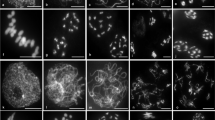Abstract
Triticum timopheevii (2n=4x=AtAtGG) is an allotetraploid wheat which shows a diploid-like behaviour at metaphase-I. The synaptic process was analyzed in fully traced spread nuclei at mid-zygotene, late-zygotene and pachytene. The length and type of synaptonemal complexes, as well as the number of bivalent and multivalent associations, were determined in each nucleus. A high number of bivalents per nucleus was detected at all three stages. Nuclei at pachytene showed a lower frequency of multivalents than did zygotene nuclei, which suggests the existence of a pairing correction mechanism. At metaphase-I only homologous bivalents and, rarely, one pair of univalents were observed. Similarities between the diploidization mechanism of T. timopheevii and that of allohexaploid wheat, controlled by chromosome 5B, are discussed.
Similar content being viewed by others
References
Badaeva ED, Budashkina EB, Badaev NS, Kalinina NP, Shkutina FM (1991) General features of chromosome substitutions in Triticum aestivum x T. timopheevii hybrids. Theor Appl Genet 82:227–232
Chen PD, Gill BS (1983) The origin of chromosome 4A, and genomes B and G of tetraploid wheat. Proc 6th Int Wheat Genet Symp, pp 39–48
Cuñado N, Callejas S, García MJ, Fernández A, Santos JL (1996) Chromosome pairing in the allotetraploid Aegilops biuncialis and a triploid intergeneric hybrid. Genome 39:664–670
Davies A, Jenkins G, Rees H (1990) Diploidisation of Lotus corniculatus L. (Fabaceae) by elimination of multivalents. Chromosoma 99:289–295
Dvorák J, Chen KC, Giorgi B (1984) The C-band pattern of a Phmutant of durum wheat. Can J Genet Cytol 26:360–363
Dvorák J, di Terlizzi P, Zhang HB, Resta P (1993) The evolution of polyploid wheat: identification of the A-genome donor species. Genome 36:21–31
Feldman M (1966) The mechanism regulating pairing in Triticum timopheevi. Wheat Inf Serv 21:1–2
Gillies CB (1989) Chromosome pairing and fertility in polyploids. In: Gillies CB (ed) Fertility and chromosome pairing: recent studies in plants and animals. CRC Press, Boca Raton, Florida, pp 137–176
Giorgi B, Barbera F (1981) Increase of homoeologous pairing in hybrids between T. turgidum L. var. durum and two tetraploid species of Aegilops: Ae. kotschy and Ae. cylindrica. Cereal Res Commun 9:205–211
Giráldez R, Cermeño MC, Orellana J (1979) Comparison of C-banding pattern in the chromosome of inbred lines and open pollinated varieties of rye. Z Pflanzenzüecht 83:40–48
Holm PB (1986) Chromosome pairing and chiasma formation in allohexaploid wheat, Triticum aestivum, analysed by spreading of meiotic nuclei. Carlsberg Res Commun 51:239–294
Holm PB, Wang X (1988) The effect of chromosome 5B on synapsis and chiasma formation in wheat, Triticum aestivum, cv Chinese Spring. Carlsberg Res Commun 53:191–208
Jenkins G (1988) Chromosome pairing in Lolium hybrids. In: Brandham PE (ed) Kew chromosome conference III. HMSO, London, pp 261–267
Jenkins G, Chatterjee R (1994) Chromosome structure and pairing preferences in autotetraploid rye (Secale cereale). Genome 37:784–793
Jenkins G, White J, Parker JS (1988) Elimination of multivalents during meiotic prophase in Scilla autumnalis. II. Tetraploid. Genome 30:940–946
Jiang J, Gill BS (1994) Different species-specific chromosome translocations in Triticum timopheevii and T. turgidum support the diphyletic origin of polyploid wheats. Chromosome Res 2:59–64
Jones M, Rees H, Jenkins G (1989) Synaptonemal complex formation in Avena polyploids. Heredity 63:209–219
Jong JH de, Havekes E, Roca A, Naranjo T (1991) Synapsis and chiasma formation in a ditelo-substituted haploid of rye. Genome 34:109–120
Loidl J (1984) Light microscopical observations on surface spread synaptonemal complexes of Allium ursinum. Caryologia 37:415–421
Ogihara Y, Tsunewaki K (1988) Diversity and evolution of chloroplast DNA in Triticum and Aegilops as revealed by restriction fragment analysis. Theor Appl Genet 76:321–332
Santos JL, Cuadrado MC, Díez M, Romero C, Cuñado N, Naranjo T, Martínez M (1995) Further insights on chromosomal pairing of autopolyploids: a triploid and tetraploids of rye. Chromosoma 104:298–307
Sears ER (1976) Genetic control of chromosome pairing in wheat. Annu Rev Genet 10:31–51
Takumi S, Nasuda S, Liu YG, Tsunewaki K (1993) Wheat phylogeny determined by RFLP analysis of nuclear DNA. 1. Einkorn wheat. Jpn J Genet 68:73–79
Thomas HM, Thomas BJ (1993) Synaptonemal complex formation in two allohexaploid Festuca species and a pentaploid hybrid. Heredity 71:305–311
Tsunewaki K, Ogihara Y (1983) The molecular basis of genetic diversity among cytoplasms of Triticum and Aegilops species. II. On the origin of polyploid wheats cytoplasms as suggested by chloroplast DNA restriction fragment patterns. Genetics 104:155–171
Author information
Authors and Affiliations
Additional information
Communicated by B. S. Gill
Rights and permissions
About this article
Cite this article
Martinez, M., Naranjo, T., Cuadrado, C. et al. Synaptic behaviour of the tetraploid wheat Triticum timopheevii . Theoret. Appl. Genetics 93, 1139–1144 (1996). https://doi.org/10.1007/BF00230137
Received:
Accepted:
Issue Date:
DOI: https://doi.org/10.1007/BF00230137




